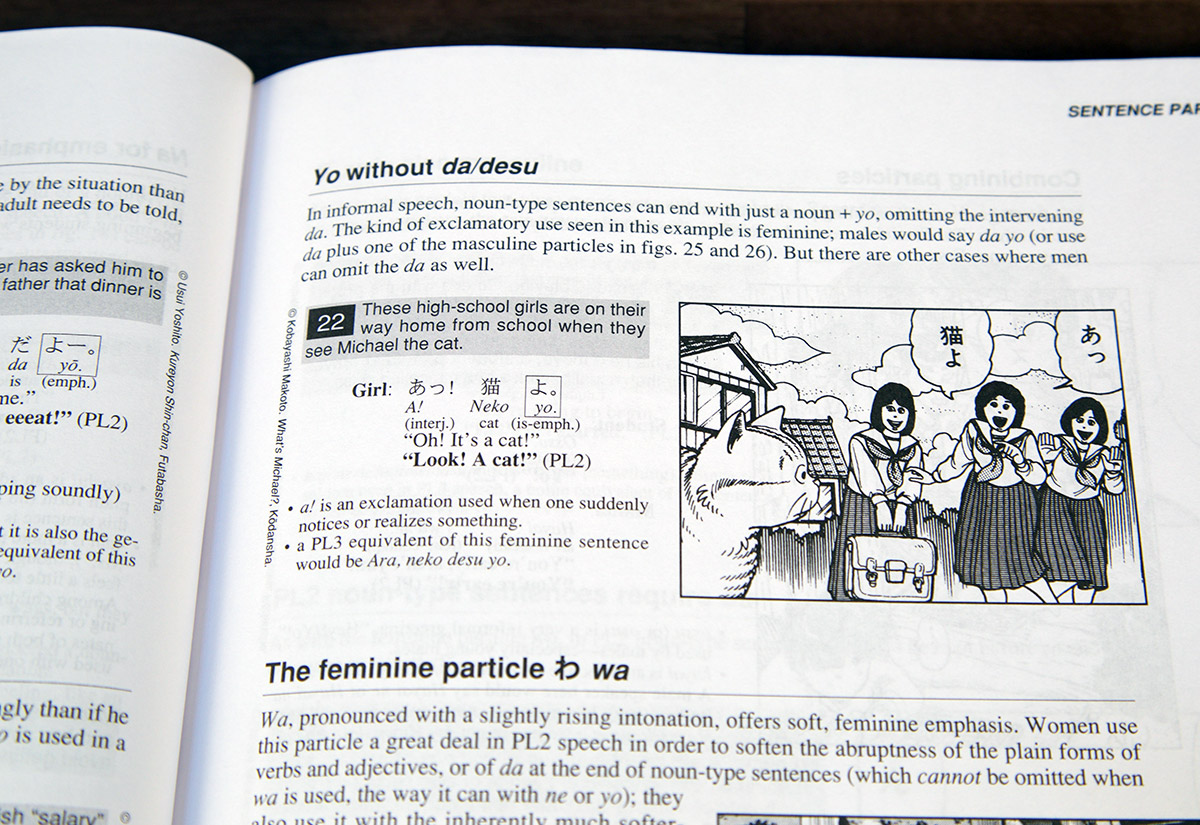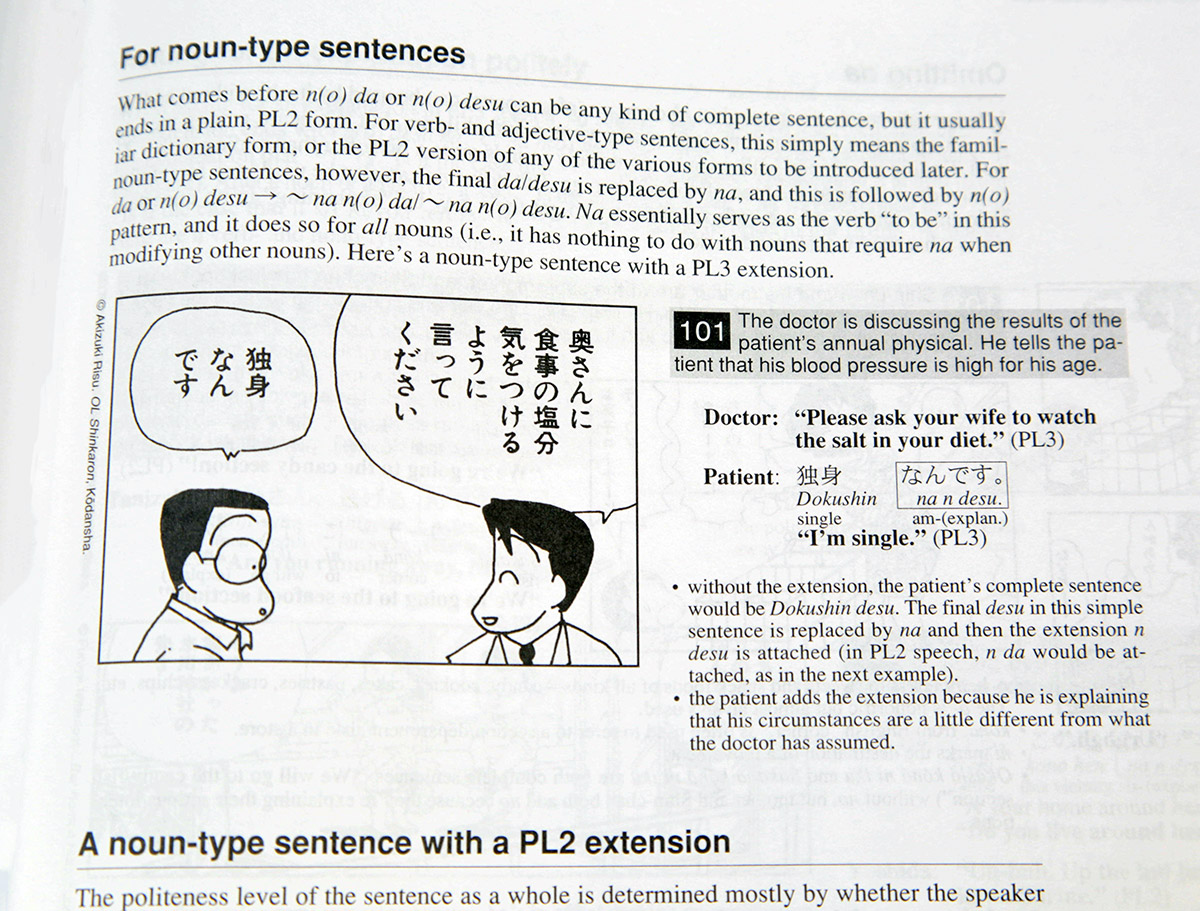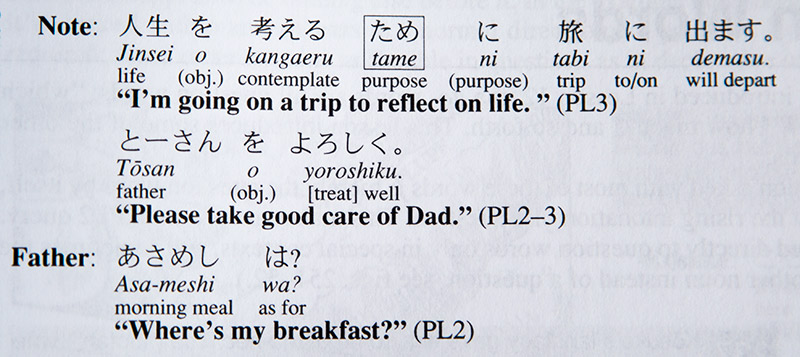If you're self-teaching Japanese and just a little past the beginning phases, you may run into a conundrum. With a handful of vocabulary and grammar points in hand, you can eke forward in conversation and written word. But oftentimes, real life Japanese will throw you vocab and grammar not covered in the early stages of textbook study. Enter: Japanese the Manga Way by Wayne P. Lammers.
Japanese the Manga Way is the perfect tool to fill in knowledge gaps for beginning and intermediate Japanese learners. It's 493 mini lessons designed to give you the detailed gist of grammar points using real Japanese that real Japanese people read. How is this done? Each mini lesson is illustrated by a panel of manga. Not fake manga cooked up by a textbook company to teach you grammar they want you to know. Real manga from real books and newspapers in Japan.
Thorough, Efficient Teaching

As stated above, Japanese the Manga Way is divided into 493 mini lessons, categorized in 32 chapters. Each lesson teaches one grammar point illustrated by one or more panels of manga. The lessons contain:
- an explanation of the grammar point
- a set up of the manga panel's story
- a translation and dissection of the manga panel's Japanese
- several follow-up bullet points that explain the linguistic or cultural specifics of the Japanese you may not know
That's a lot of information packed into a half page!

The beauty of this book is its simplicity. Everything is bite size and concisely explained, with very little room for confusion. Author Lammers even goes as far as to break the entire Japanese language into 3 basic sentence types: verb, noun, and adjective sentences. From there he builds and builds, starting with the simplest Japanese and ending with the more complicated. The style and format is easily consumable and good for those who have been frustrated by the daunting task of Japanese study. Lammers is offering a learning environment in which you can learn step by step, brick by brick.
Another advantage of the book is the way each manga example reinforces the grammar point. Rather than having a cast of characters (Robert and Hiroshi!) who repeatedly give voice to each lesson, the real manga examples assign this task to a wide range of cameos from actual manga. One lesson may star Crayon Shin-chan, and the next may feature Captain Tsubasa. This gives your brain a chance to glue the Japanese you've learned to a specific character and situation, not unlike the way you may retain vivid memories of stories you've experienced or read in your own language.
The Drawbacks

Instead of the common "-u verb" and "-ru verb" (or the best godan and ichidan definitions) used to describe the two types of Japanese verbs, Lammers calls them "type 1" and "type 2". Instead of "plain form", "polite form" and so on to describe the different politeness levels, Lammers uses "PL1" through "PL4", wherein "PL" stands for "politeness level". There's nothing incorrect about this lexicon, but some learners already familiar with certain terms may find it initially difficult to make the switch in their brains. This switch, however, is a small price to pay for all the knowledge gained by the end of the book.
The major drawback of this book is its use of romaji throughout. It was probably added to lower the bar of entry, which is understandable from a publishing standpoint. Easier access = easier sell. But from an academic standpoint, romaji is a major hindrance to Japanese learning and has no practical value in real world situations. Are you one of these people? You can learn hiragana right now.
In addition to this, there is no audio accompaniment with this textbook, so you're on your own when it comes to pronunciation and listening. There's no workbook as well, though the text itself has a lot of information. To get the most out of this text, you'll want to create your own notes and drill the topics on your own without the help of a workbook. So, certainly not a deal breaker, and certainly not something that's expected of a textbook to have, but these additions would have turned my favorite textbook into my favoritest favoritest textbook.
Expert Tips from an Expert Linguist

Wayne P. Lammers is a native Japanese speaker and linguist. What you get from Japanese the Manga Way is a different experience from traditional textbooks. It's a crash course to be sure, but Lammers is expertly crashing you into the most pertinent information and explaining it in a way that is easy digestible. For those who want the most efficient path to beefing up their Japanese knowledge, this is a very good option.
It is worth mentioning that the manga used in this book's examples is 80s and 90s slice of life manga. No robots or superheroes here. This is good news as you'll be learning useful Japanese rather than, "You will never defeat me!" or "He's summoning energy from the universe!"
Japanese the Manga Way is unique among textbooks and not to be missed for mid beginners and intermediates. If you keep running into grammar you don't understand, this is the book for you. It dives deep into Japanese, stopping just short of high-intermediate and low-expert levels. Grab this book when you see it and pray that eventually there will be a second volume (without romaji).
Michael’s Review
Back when I used this book, it was exactly what I needed: short and simple explanations of grammar concepts I could quickly ingest and start using. The manga examples made the grammar easy to understand, and the author did a good job making each grammar point clear. Unfortunately, the use of romaji knocks it down a peg and makes it unsuitable as a long term study tool. It’s good if you know just a little bit of Japanese and want to flesh out your grammar knowledge. But past that point, you should reach for a fuller textbook.
